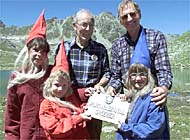Lavin: a tiny village that moved a mountain

Every one of Lavin's 200 citizens - young and old - was there. They had pulled on their hiking boots, donned their sun hats, and marched uphill for four gruelling hours to reach the plateau lying one kilometre above their village.
Speeches were made in Switzerland’s fourth national language, Romansch. Alphorns blew. Dignitaries came from Berne. Television cameras rolled. The small community of Lavin was enjoying its moment in the sun.
The event was to mark the official handing over of the plateau and its lakes to the Swiss National Park. It was quite an occasion for Lavin as well as park officials. The park’s management had spent the better part of the 20th century trying to expand the park boundaries with only limited success. No land had been annexed in nearly 40 years.
It took the citizens of Lavin to get the ball rolling again. After more than three years of heated debate, they voted to lease the Lakes of Macun to the National Park. Lavin will receive SFr20,000 a year. In return, the park gets a couple of dozen small lakes, frozen for much of the year, and the sparse vegetation surrounding them.
Among those listening to the speeches was Robert Giacometti. Until March, he was head of the village council, and the man responsible for negotiating the deal for Lavin. Now he’s back to running his bakery full-time.
Biscuits and nut tarts – a speciality of the region – were handed out to everyone in attendance, also thanks to Giacometti.
Like many people in Lavin, Giacometti started hiking up to the lakes as a child with his grandparents. They probably explained the legend of the dragon and dwarves (see lead story), and showed him the rare flowers that only grow around the lakes.
As an adult he collected other kinds of trophies. He’s a hunter, and proudly claims to be the last person to have shot a chamois on Macun. That was last year. Hunting and fishing are now banned.
The park founders had Macun in their sights 90 years ago. The proposed deal, which was never signed, included a clause to ensure that the people of Lavin would be compensated for any damage caused by resident bears. They need not have worried. The last bears were seen years earlier, and to this day they still haven’t returned to Switzerland.
There’s much applause after a plaque is unveiled, and then most people take lunch, pulling sandwiches and chocolate bars out of their backpacks.
A steady stream of people flows back down to Lavin, through the high valley of Zeznina, which belongs to the village and is still used as an alpine pasture. A family from Germany take care of the livestock in the valley now. It’s a scene repeated across Switzerland. The Swiss have lost interest in the long-hours and back-breaking work required to farm in the Alps.
Back in Lavin, the village authorities and park officials change into suits and ties for a news conference. They aren’t as relaxed as before and have to face pointed questions from journalists who were unwilling to make the trek up to the plateau.
Giacometti’s successor, Rico Bonifazi, says he hopes Lavin’s decision will not poison its relations with neighbouring communities, which are still uncertain about handing over any of their land to the park.
But he prefers to talk about the new opportunities Lavin has been given by the park expansion. He thinks more tourists interested in hiking in the park will now choose to stay in one of Lavin’s two hotels. And he says Lavin’s position as a “National Park community” will help it to better market its products.
Those products are truly home-grown. Around the corner and across the square from the council building is Giacometti’s bakery. On this evening, a tractor blocks the main road through town while farmers unload a wagon full of hay. The barn doubles as the village post office.
The following morning, the deserted streets are a sign that life has returned to normal for the people of Lavin. There’s a light coming from the ground floor of the council building. It houses the local dairy.
by Dale Bechtel

In compliance with the JTI standards
More: SWI swissinfo.ch certified by the Journalism Trust Initiative

You can find an overview of ongoing debates with our journalists here . Please join us!
If you want to start a conversation about a topic raised in this article or want to report factual errors, email us at english@swissinfo.ch.